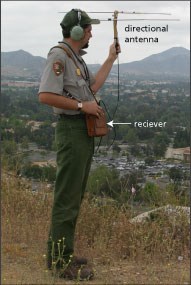
National Park Service Radio-telemetry uses radio signals to locate animals and follow their movements. Radio-telemetry involves two components - a transmitter and a receiver. The transmitter is attached to a collar worn by an animal, in this case, the bobcat. The transmitters emit a signal on a specific frequency that can be monitored by a receiver and each bobcat is given a unique frequency. The receiver is a small radio-like device fitted with a special directional antenna. The antenna receives the signal and inputs it into the receiver. The receiver interprets the signal and calculates the strength, measured in audible 'beeps'. Strong signal strength indicates the signal is directly ahead and is expressed by loud beeps. Sweeping the antenna in a 360-degree arc will aid in finding the strongest signal (i.e., the loudest beeps). Once the direction is determined, using a compass, a bearing can be made (a bearing is the angle from north, where north is 0 degrees, east is 90 degrees, south is 180 degrees, etc.). A second and, sometimes, a third bearing from a different location is usually made within a short period of time from the first bearing measurement. Using the intersections of the bearings, as well as, the location of where the bearings were made (i.e., by GPS), the animal's location can then be determined. |
Last updated: March 1, 2015
